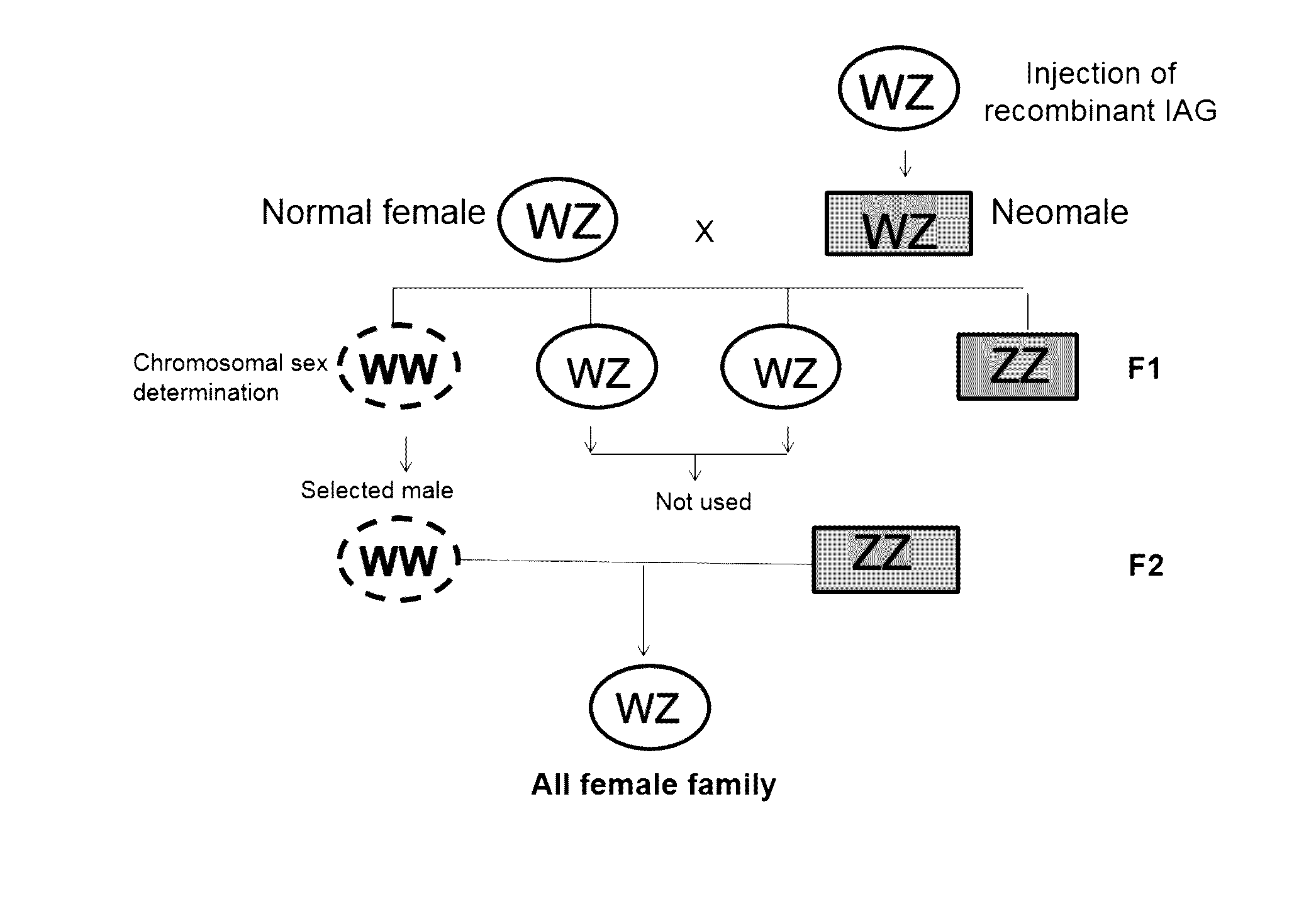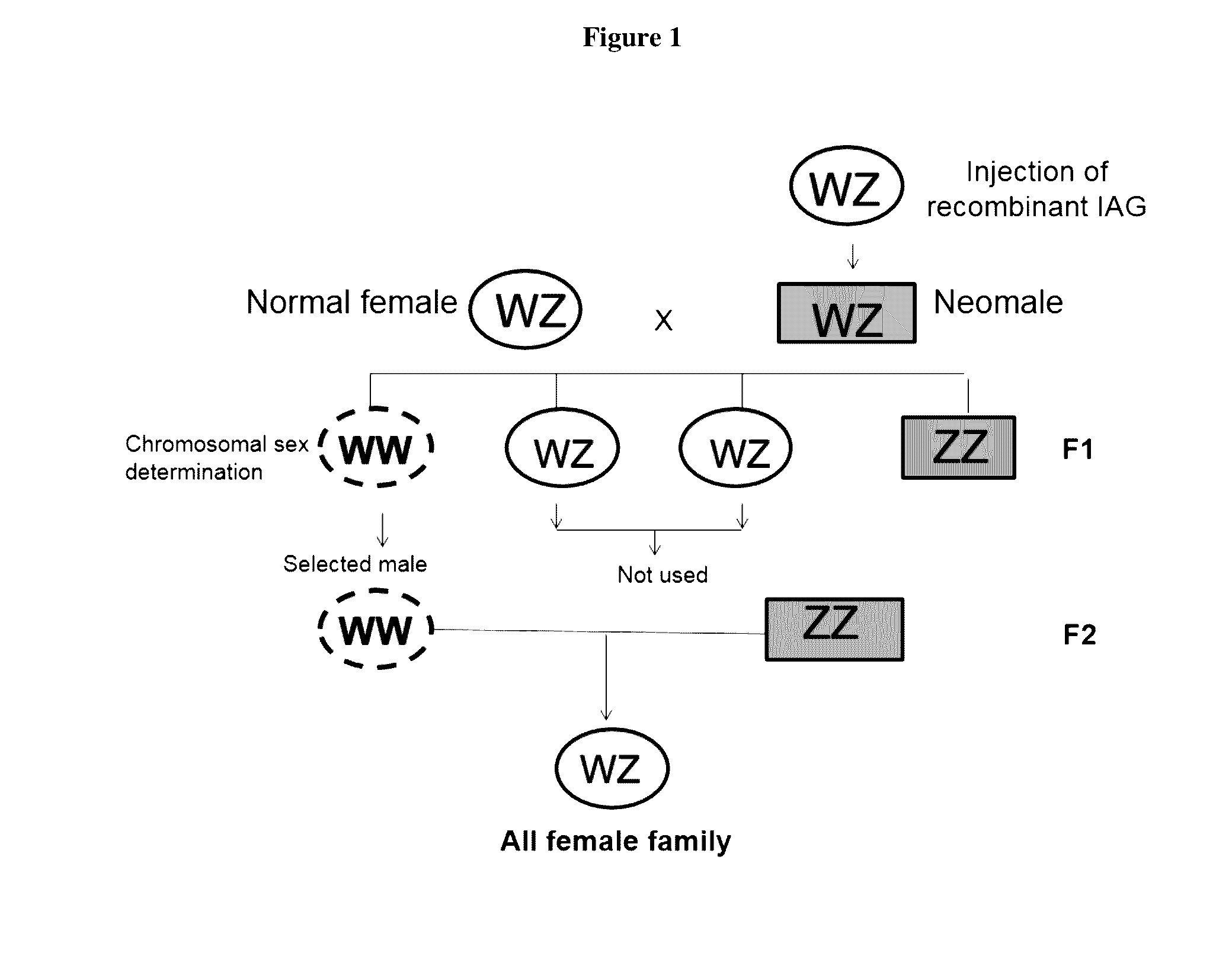Moderation of crustacean androgenic gland peptide for mono sex culture
a technology of gland peptide and mono sex culture, which is applied in the field of moderating crustacean androgenic gland peptide, can solve the problems of low success rate, yy males which are not 100% viable, and hampered biotechnology
- Summary
- Abstract
- Description
- Claims
- Application Information
AI Technical Summary
Benefits of technology
Problems solved by technology
Method used
Image
Examples
example 1
Knock-Down IAG Gene Expression by RNA Interference
[0106]To produce an all female shrimp culture, a simple approach is to inject dsRNA for IAG gene into a male shrimp. In one embodiment, the best time to inject the dsRNA is when they are young, or sexually undifferentiated. For example, for P. monodon (largest female sometime reach 23 cm or 180 grams), one should inject them when they are about 2.5-3.0 cm long. Inject all the small shrimp and later determine if all of the shrimp are female. A deviation of the 1:1 ratio.
[0107]In another embodiment, juvenile shrimp of 2.5-3.0 cm is selected for sex identification. Twenty male shrimps is selected and injected with dsRNA for IAG (e.g. 1 μg / g of body weight). The control male shrimps are injected with PBS only. The two groups are cultured separately and the same injection procedure is repeated when they molt again. Most of the shrimps injected with the dsRNA should lose the secondary sexual characteristics (e.g. the appendix masculine of ...
example 2
Knock-Down IAG Gene Expression by RNA Interference using a Spermatophore
[0109]Shrimp can be artificially inseminated with a spermatophore (a sperm sac). The sperm sac is collected from the male shrimp. dsRNA for the IAG gene is mixed with the collected sperm sac. When the female molts and the exoskeleton is soft, the sperm sac with dsRNA is inserted into the female thylecum (sperm receptacle), preferably 1-2 days after she molted. The sperm sac, together with the dsRNA, will remain in the female body and silence the IAG gene. Ovary will continue to develop for the next 5-6 days. The female is injected with dsRNA for the IAG gene (e.g. 10 ug / g of body weight) 1 to 2 days before she spawns.
[0110]When the female spawns, the eggs (which contain either a Z or W chromosome) will be fertilized by the sperm (with Z chromosome). The eggs with W chromosome that are fertilized by the Z sperm will become a normal female (ZW). The eggs with Z chromosome that are fertilized by the Z sperm will tu...
example 3
Obtaining a Monosex Culture Using Recombinant IAG Peptide
[0112]As illustrated in FIG. 1, a monosex culture of female crustacean such as shrimp or lobster can also be obtained by introducing a recombinant IAG peptide into the female crustacean.
[0113]Firstly, female crustacean such as shrimps (ZW) are selected during early stage of sexual development at intermolt stage. In one embodiment, shrimps at the early stage of 2-3 cm in total length are selected for injection. In another embodiment, shrimps at the early stage of 3-4 cm in total length are selected for injection.
[0114]The selected shrimps are then injected with a recombinant protein for IAG (insulin-like androgenic gland hormone). When the females reach the intermolt stage of the next molting cycle, the females are injected with a recombinant protein for IAG again. In one embodiment, the concentration of recombinant IAG protein used for injection is slightly higher than the physiological concentration of the IAG protein in the ...
PUM
 Login to View More
Login to View More Abstract
Description
Claims
Application Information
 Login to View More
Login to View More - R&D
- Intellectual Property
- Life Sciences
- Materials
- Tech Scout
- Unparalleled Data Quality
- Higher Quality Content
- 60% Fewer Hallucinations
Browse by: Latest US Patents, China's latest patents, Technical Efficacy Thesaurus, Application Domain, Technology Topic, Popular Technical Reports.
© 2025 PatSnap. All rights reserved.Legal|Privacy policy|Modern Slavery Act Transparency Statement|Sitemap|About US| Contact US: help@patsnap.com


